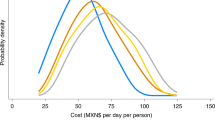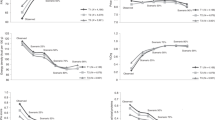Abstract
Energy-dense diets offer a low-cost dietary option to the consumer. However, they are more likely to be nutrient-poor. In this study, based on the French national food consumption survey, the diet costs were estimated using retail food prices in France. Adult participants were stratified by quartiles of energy cost (in €/10 MJ). Dietary energy density, energy and nutrient intakes were then compared across groups. Participants in the lowest quartile of energy cost had the highest energy intakes, the most energy-dense diets and the lowest daily intakes of key vitamins and micronutrients. Participants in the highest quartile of energy cost had lower energy intakes, and diets that were higher in nutrients and lower in energy density. However, their daily diet costs were 165% higher. In this observational study, the more nutrient-dense diets were associated with higher diet costs.
This is a preview of subscription content, access via your institution
Access options
Subscribe to this journal
Receive 12 print issues and online access
$259.00 per year
only $21.58 per issue
Buy this article
- Purchase on Springer Link
- Instant access to full article PDF
Prices may be subject to local taxes which are calculated during checkout
Similar content being viewed by others
References
Cade J, Upmeier H, Calvert C, Greenwood D (1999). Costs of a healthy diet: analysis from the UK Women's Cohort Study. Publ Health Nutr 2, 505–512.
Darmon N, Briend A, Drewnowski A (2004). Energy-dense diets are associated with lower diet costs: a community study of French adults. Publ Health Nutr 7, 21–27.
Darmon N, Darmon M, Maillot M, Drewnowski A (2005). Nutrient adequacy of vegetables and fruit: nutrients per calorie and nutrients per unit cost. J Am Diet Assoc (in press).
Darmon N, Ferguson E, Briend A (2003). Do economic constraints encourage the selection of energy dense diets? Appetite 41, 315–322.
Darmon N, Ferguson E, Briend A (2006). Marked changes to habitual dietary patterns are required to select a nutritionally adequate diet on a low food budget. J Nutr Educ Behav (in press).
Darmon N, Ferguson EL, Briend A (2002). A cost constraint alone has adverse effects on food selection and nutrient density: an analysis of human diets by linear programming. J Nutr 132, 3764–3771.
Drewnowski A, Darmon N (2005). The economics of obesity: dietary energy density and energy cost. Am J Clin Nutr 82, 265S–273S.
Drewnowski A, Darmon N, Briend A (2004). Replacing fats and sweets with vegetables and fruit – a question of cost. Am J Pub Health 94, 1555–1559.
Favier J, Ireland-Ripert J, Toque C, Feinberg M (1995). CIQUAL. Répertoire Général des Aliments. Table de composition. CIQUAL. 2e. Paris, Lavoisier, Tec&Doc.
James WP, Nelson M, Ralph A, Leather S (1997). Socioeconomic determinants of health. The contribution of nutrition to inequalities in health. BMJ 314, 1545–1549.
Kunst AE, Groenhof F, Mackenbach JP, Health EW (1998). Occupational class and cause specific mortality in middle aged men in 11 European countries: comparison of population based studies. EU Working Group on Socioeconomic Inequalities in Health. BMJ 316, 1636–1642.
Leather S, Dowler E (1997). Intake of micronutrients in Britain's poorest fifth has declined. BMJ 314, 1412–1413.
Marti-Henneberg C, Capdevila F, Arija V, Perez S, Cuco G, Vizmanos B et al. (1999). Energy density of the diet, food volume and energy intake by age and sex in a healthy population. Eur J Clin Nutr 53, 421–428.
Molarius A, Seidell JC, Sans S, Tuomilehto J, Kuulasmaa K (2000). Educational level, relative body weight, and changes in their association over 10 years: an international perspective from the WHO MONICA Project. Am J Publ Health 90, 1260–1268.
Poppitt SD, Prentice AM (1996). Energy density and its role in the control of food intake: evidence from metabolic and community studies. Appetite 26, 153–174.
Roos E, Prattala R, Lahelma E, Kleemola P, Pietinen P (1996). Modern and healthy? socioeconomic differences in the quality of diet. Eur J Clin Nutr 50, 753–760.
Stallone DD, Brunner EJ, Bingham SA, Marmot MG (1997). Dietary assessment in Whitehall II: the influence of reporting bias on apparent socioeconomic variation in nutrient intakes. Eur J Clin Nutr 51, 815–825.
Volatier J-L (2000). Enquête INCA (Individuelle et Nationale sur les Consommations Alimentaires). AFSSA, Agence Française de Sécurité Sanitaire des Aliments, Editor. AFSSA, Agence Française de Sécurité Sanitaire des Aliments. Paris, Lavoisier, Tec&Doc.
WHO (2003). Diet, nutrition and the prevention of excess weight gain and obesity, Report of a joint WHO/FAO expert consultation. WHO: Geneva. Technical report, series 916.
Willett W, Stampfer MJ (1986). Total energy intake: implications for epidemiologic analyses. Am J Epidemiol 124, 17–27.
Acknowledgements
We are grateful to Jean-Luc Volatier for providing us the access to the INCA database and to France Caillavet for providing us the access to the SECODIP database.
Author information
Authors and Affiliations
Corresponding author
Rights and permissions
About this article
Cite this article
Andrieu, E., Darmon, N. & Drewnowski, A. Low-cost diets: more energy, fewer nutrients. Eur J Clin Nutr 60, 434–436 (2006). https://doi.org/10.1038/sj.ejcn.1602331
Received:
Revised:
Accepted:
Published:
Issue Date:
DOI: https://doi.org/10.1038/sj.ejcn.1602331
Keywords
This article is cited by
-
Influence of maternal and paternal pre-conception overweight/obesity on offspring outcomes and strategies for prevention
European Journal of Clinical Nutrition (2021)
-
Healthy and Unhealthy Food Prices across Neighborhoods and Their Association with Neighborhood Socioeconomic Status and Proportion Black/Hispanic
Journal of Urban Health (2017)
-
Do SNAP and WIC Programs Encourage More Fruit and Vegetable Intake? A Household Survey in the Northern Great Plains
Journal of Family and Economic Issues (2015)
-
Does diet cost mediate the relation between socioeconomic position and diet quality?
European Journal of Clinical Nutrition (2011)
-
Prioritizing micronutrients for the purpose of reviewing their requirements: a protocol developed by EURRECA
European Journal of Clinical Nutrition (2010)



